| This article needs additional citations for verification. Please help improve this article by adding citations to reliable sources. Unsourced material may be challenged and removed. Find sources: "Canting arms" – news · newspapers · books · scholar · JSTOR (August 2011) (Learn how and when to remove this message) |

Canting arms are heraldic bearings that represent the bearer's name (or, less often, some attribute or function) in a visual pun or rebus.
The expression derives from the latin cantare (to sing). French heralds used the term armes parlantes (English: "talking arms"), as they would sound out the name of the armiger. Many armorial allusions require research for elucidation because of changes in language and dialect that have occurred over the past millennium.
Canting arms – some in the form of rebuses – are quite common in German civic heraldry. They have also been increasingly used in the 20th century among the British royal family. When the visual representation is expressed through a rebus, this is sometimes called a rebus coat of arms. An in-joke among the Society for Creative Anachronism heralds is the pun, "Heralds don't pun; they cant."
Examples of canting arms
Personal coats of arms
A famous example of canting arms are those of Queen Elizabeth The Queen Mother's paternal family, the Bowes-Lyon family. The arms (pictured below) contain the bows and blue lions that make up the arms of the Bowes and Lyon families.
-
 Bowes-Lyon family: bows and lions
Bowes-Lyon family: bows and lions
-
 Princess Beatrice of York: Beatrice = bee thrice = three bees
Princess Beatrice of York: Beatrice = bee thrice = three bees
-
 Rosetti family: three roses
Rosetti family: three roses
-
 Quintin Hogg, Baron Hailsham of St Marylebone: three hog's heads
Quintin Hogg, Baron Hailsham of St Marylebone: three hog's heads
-
 Cockburn: three red cocks
Cockburn: three red cocks
-
 Crowninshield family: crown on the shield
Crowninshield family: crown on the shield
-
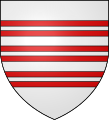 De Barry family: three bars gemelles
De Barry family: three bars gemelles
-
 Coat of arms of the head of the Portuguese Costa family: costa means "rib" in Latin and Portuguese
Coat of arms of the head of the Portuguese Costa family: costa means "rib" in Latin and Portuguese
-
 President Eisenhower: a blacksmith's anvil, as Eisenhauer is German for "iron-hewer"
President Eisenhower: a blacksmith's anvil, as Eisenhauer is German for "iron-hewer"
-
 Flag of Maryland, originally the arms of George Calvert, 1st Baron Baltimore, whose mother's maiden name was Crossland; the latter's arms shows a cross.
Flag of Maryland, originally the arms of George Calvert, 1st Baron Baltimore, whose mother's maiden name was Crossland; the latter's arms shows a cross.
-
 Theodore Roosevelt: roses-fields
Theodore Roosevelt: roses-fields
-
 Maus family: a mouse in the first and fourth quarters.
Maus family: a mouse in the first and fourth quarters.
-
 Anthony Rota: rota means "wheel" in Latin
Anthony Rota: rota means "wheel" in Latin
-
 Edwin Forrest: Three trees and a tree crest (forest)
Edwin Forrest: Three trees and a tree crest (forest)
-
 Arms of the Campdavaine branch of the counts of Saint-Pol: a sheaf of oats (Camp d'avaine means field of oats in that family's Picard language ).
Arms of the Campdavaine branch of the counts of Saint-Pol: a sheaf of oats (Camp d'avaine means field of oats in that family's Picard language ).
Municipal coats of arms
Municipal coats of arms which interpret the town's name in rebus form are also called canting. Here are a few examples.
-
 The arms of Berwickshire, Scotland: Bear and Wych Elm
The arms of Berwickshire, Scotland: Bear and Wych Elm
-
 Elmbridge, Surrey (1974): elm tree on bridge. (The toponym is related to bridges but not to elms; the prefix refers to Emel, a former name for the river Mole.)
Elmbridge, Surrey (1974): elm tree on bridge. (The toponym is related to bridges but not to elms; the prefix refers to Emel, a former name for the river Mole.)
-
 Châteaurenard: Château = castle; Renard = fox
Châteaurenard: Château = castle; Renard = fox
-
 Eberbach (1976): Eber = boar; Bach = brook (wavy blue fess)
Eberbach (1976): Eber = boar; Bach = brook (wavy blue fess)
-
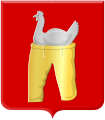 The coat of arms of the village of Hensbroek in North Holland interprets the toponym as "hen-breeches" (the toponym is unrelated to either "hen" or "breeches", deriving from the personal name Hein and the Dutch cognate of "brook", i.e. "Henry's brook".)
The coat of arms of the village of Hensbroek in North Holland interprets the toponym as "hen-breeches" (the toponym is unrelated to either "hen" or "breeches", deriving from the personal name Hein and the Dutch cognate of "brook", i.e. "Henry's brook".)
-
 Freixo de Espada à Cinta (1926): Freixo = ash (tree); de Espada = with sword; à Cinta = at the waist, in Portuguese
Freixo de Espada à Cinta (1926): Freixo = ash (tree); de Espada = with sword; à Cinta = at the waist, in Portuguese
-
 Falkenberg (1948): Falken = falcon; Berg = hill, in Swedish
Falkenberg (1948): Falken = falcon; Berg = hill, in Swedish
-
 Seinäjoki (1951): seinä = wall, joki = river, in Finnish
Seinäjoki (1951): seinä = wall, joki = river, in Finnish
-
 Arms of Kontiolahti featuring a bear (kontio in Finnish), carrying a log driving pike pole referring to the importance of forestry in the region's economy
Arms of Kontiolahti featuring a bear (kontio in Finnish), carrying a log driving pike pole referring to the importance of forestry in the region's economy
-
 Berlin (1954): Bär = bear
Berlin (1954): Bär = bear
-
 City and canton of Bern: Bär = Bear
City and canton of Bern: Bär = Bear
-
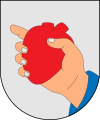 Manacor: man a cor = hand with heart, in Catalan
Manacor: man a cor = hand with heart, in Catalan
-
 Torrevieja (1829): Torre = tower, vieja = old
Torrevieja (1829): Torre = tower, vieja = old
-
 Kryvyi Rih: Kryvyi = crooked, Rih = horn, in Ukrainian
Kryvyi Rih: Kryvyi = crooked, Rih = horn, in Ukrainian
-
 Rueda (1986): rueda = wheel in Spanish
Rueda (1986): rueda = wheel in Spanish
-
 Łódź: Łódź = boat
Łódź: Łódź = boat
-
 Wolfsburg: Wolf's Castle
Wolfsburg: Wolf's Castle
-
 Arms of Magenta, France, feature a bend sinister in magenta, an extremely rare tincture in heraldry
Arms of Magenta, France, feature a bend sinister in magenta, an extremely rare tincture in heraldry
-
 Örnsköldsvik (1894): Örn = Eagle, Sköld = Shield and Vik = Bay.
Örnsköldsvik (1894): Örn = Eagle, Sköld = Shield and Vik = Bay.
-
 Füssen: Füße = feet
Füssen: Füße = feet
-
 Schaffhausen: Schaf = sheep, Haus = house
Schaffhausen: Schaf = sheep, Haus = house
-
 Steinhaus: Stein = stone, Haus = house
Steinhaus: Stein = stone, Haus = house
-
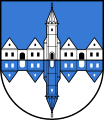 Schattendorf: Schatten = shadow, Dorf = village
Schattendorf: Schatten = shadow, Dorf = village
-
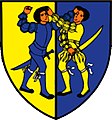 Hadersdorf-Kammern: Hader = quarrel, Dorf = village
Hadersdorf-Kammern: Hader = quarrel, Dorf = village
-
 The arms of Dornbirn feature pears, Birn in German
The arms of Dornbirn feature pears, Birn in German
-
 The arms of Kotka feature an eagle (kotka in Finnish)
The arms of Kotka feature an eagle (kotka in Finnish)
-
 An example of canting arms outside Europe: the Malaysian city of Kuching features a cat on its municipal coat of arms, kuc(h)ing being the Malay word for cat
An example of canting arms outside Europe: the Malaysian city of Kuching features a cat on its municipal coat of arms, kuc(h)ing being the Malay word for cat
Ecclesiastical coats of arms
-
 The arms of the Diocese of Lansing: The lances crossed per saltire are a play on the name of the see, the city of Lansing, Michigan.
The arms of the Diocese of Lansing: The lances crossed per saltire are a play on the name of the see, the city of Lansing, Michigan.
-
 The arms of the Diocese of Rockville Centre: The mounds in the circle at the center of the arms are a play on the name of city in which the diocese is based, Rockville Centre, New York.
The arms of the Diocese of Rockville Centre: The mounds in the circle at the center of the arms are a play on the name of city in which the diocese is based, Rockville Centre, New York.
-
 The arms of the Diocese of Baton Rouge: The shield features a red baton, referencing the city name, Baton Rouge, Louisiana, and its literal French meaning.
The arms of the Diocese of Baton Rouge: The shield features a red baton, referencing the city name, Baton Rouge, Louisiana, and its literal French meaning.
-
 The arms of the Diocese of Buffalo: The arms feature an American bison, colloquially called a buffalo, carrying a banner of the Cross of St. George (analogous to the heraldic Lamb of God), referencing the name of city in which the see is based, Buffalo, New York.
The arms of the Diocese of Buffalo: The arms feature an American bison, colloquially called a buffalo, carrying a banner of the Cross of St. George (analogous to the heraldic Lamb of God), referencing the name of city in which the see is based, Buffalo, New York.
-
 The arms of the Diocese of Brownsville: The tincture of the field, tenné, is depicted as brown, referencing the seat of the diocese, Brownsville, Texas.
The arms of the Diocese of Brownsville: The tincture of the field, tenné, is depicted as brown, referencing the seat of the diocese, Brownsville, Texas.
-
 The arms of the Diocese of Phoenix: The arms feature a phoenix, the namesake of the diocesan seat, Phoenix, Arizona.
The arms of the Diocese of Phoenix: The arms feature a phoenix, the namesake of the diocesan seat, Phoenix, Arizona.
-
 The arms of the Diocese of Fort Worth: The arms feature a castle, referencing the fort for which the city, Fort Worth, Texas, was named.
The arms of the Diocese of Fort Worth: The arms feature a castle, referencing the fort for which the city, Fort Worth, Texas, was named.
-
 The arms of the Archdiocese of Anchorage: The anchor references the namesake of the see, Anchorage, Alaska.
The arms of the Archdiocese of Anchorage: The anchor references the namesake of the see, Anchorage, Alaska.
-
 The arms of the Archdiocese of Hartford: The arms feature a hart, a male deer, in the midst of flowing water, i.e., fording a body of water, referencing the name of the see, Hartford, Connecticut.
The arms of the Archdiocese of Hartford: The arms feature a hart, a male deer, in the midst of flowing water, i.e., fording a body of water, referencing the name of the see, Hartford, Connecticut.
-
 The arms of the Archdiocese of Los Angeles: The arms feature three pairs of wings, denoting three angels, and referencing the namesake of the see, Los Angeles, California, which translates to "the angels."
The arms of the Archdiocese of Los Angeles: The arms feature three pairs of wings, denoting three angels, and referencing the namesake of the see, Los Angeles, California, which translates to "the angels."
See also
Notes
- "Tinctures". www.heraldica.org.
- Neznanich, Modar. "Heraldry for Those Who Cant" (PDF). Retrieved 2 July 2012. Cites 72 historical examples of canting arms, as well as SCA usage.
- Englefield, Eric (1979). Flags. Ward Lock. p. 104.
- Room, Adrian (1988). Dictionary Of Place Names In The British Isles. Bloomsbury. p. 128. ISBN 9780747501701.
- Suomen kunnallisvaakunat (in Finnish). Suomen Kunnallisliitto. 1982. p. 139. ISBN 951-773-085-3.
- Schneider, Klaus-Michael. "Municipality of Manacor". Flags of the World. CRW Flags. Retrieved 16 October 2013.
- "Bishop Boyea arms". Diocese of Lansing. Roman Catholic Diocese of Lansing. Retrieved 9 May 2017.
- "Bishop Barres arms". Diocese of Rockville Centre. Roman Catholic Diocese of Rockville Centre. Archived from the original on 27 July 2018. Retrieved 26 July 2018.
Sources
- Winifred Hall: Canting and Allusive Arms of England and Wales. 1966. ISBN 9780900023019
References
- "Meaning of Arms". Heraldica.org. 2001-06-20.
External links
- Canting arms (Britannica)
- Canting arms – 100 armes parlantes (YouTube)
| Heraldry | |||||||||||||||
|---|---|---|---|---|---|---|---|---|---|---|---|---|---|---|---|
| Types | |||||||||||||||
| Topics | |||||||||||||||
| Achievement | |||||||||||||||
| Charges | |||||||||||||||
| Tinctures |
| ||||||||||||||
| Applications | |||||||||||||||
| Related | |||||||||||||||
| |||||||||||||||